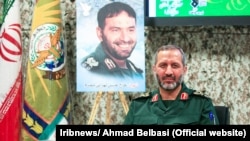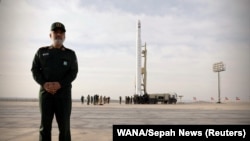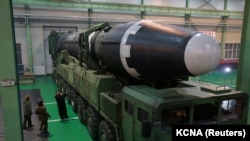In recent years, barely a week has passed without a media appearance of Amirali Hajizadeh, the media-savvy commander of the IRGC Aerospace Force. Charming, gregarious and always wearing a smile, Hajizadeh doesn't miss any opportunity to talk about drones, domestic car production and the rapid growth of Iran's missile force while carefully ignoring more inconvenient topics such as the downing of Flight 752.
It came as a bit of a surprise, then, when on November 11, his deputy Seyyed Majid Mousavi attended in his absence the presentation of two new missile-related books published on the anniversary of the martyrdom of Hassan Tehrani Moghaddam, the founder of Iran's missile force. Some immediately tied the presence of Musavi to swirling rumors about Hajizadeh's health and alleged COVID-19 infection, as reported by the web site Event24.
However, over the course of the presser, Mousavi delivered remarks that might be more consequential than any health rumors related to IRGC top brass. In what at first seemed like standard phrasing, Mousavi boasted about Iran now possessing a full range of missile capabilities including "medium-range, long-range and short-range." However, when his remarks were paraphrased by an IRIB news broadcast, another word appeared, "intercontinental." The same term was used in a Mehr News article describing the event. Closer examination of the original footage of Musavi's remarks reveals that he indeed uttered another term after "short-range" that was subsequently edited out and replaced with a sneeze from the audience.
The mention of an Iranian intercontinental ballistic missile (ICBM) capability is a stunning reversal from Iran's previous official line. So far, Iran has committed to voluntarily restrict the range of its missiles to 2000km, far short of the 5500km that constitute the lower threshold of ICBM ranges. While Iran has never flight-tested an ICBM, allegations that the country is working on such systems have been voiced several times before. Israel's Prime Minister Benyamin Netanyahu alleged that Iran is "working on far, far greater ranges" than the 2000km currently in its arsenal, while the U.S. government has claimed that Iran's space program is largely a cover for the development of ICBM technology.
The Simorgh satellite launch vehicle
So what exactly could the ICBM capability that Mousavi mentioned be? Indeed, there are several capabilities that the IRGC Aerospace Force Deputy to which he might have referred.
The first stage of Iran's largest satellite launch vehicle (SLV), the Simorgh, could theoretically be used as the basis for a future Iranian ICBM. However, the Simorgh's propulsion technology is somewhat antiquated, resulting in a large clumsy and immobile rocket that must be fired from fixed positions, which takes a long time to fuel and consequently is of limited military value. Therefore, it seems unlikely that Iran would base future ICBM development on the Simorgh.
The IRGC Space Program
A far more likely candidate is the IRGC's SLV program. Initiated in the mid-2000s, the program has focused on more advanced solid propellant technology which is much more viable for military applications. Directed by the founder of Iran's missile program, Hassan Tehrani Moghaddam, the program was run in complete secrecy by a parallel institutional arrangement, separate from Iran's established missile industry. Many indications point towards the program as a hedging strategy for ICBM technology under the guise of space flight. Much like Iran's current nuclear program, the IRGC's SLV project would likely not produce an actual weapon, but rather the technological basis to rapidly produce weapons should the need ever arise.
The program suffered a severe setback in November 2011, when a large explosion destroyed its main development facility in Bidganeh and killed Moghaddam in what might have been an accident or sabotage. After working in secrecy for more than a decade, Iran finally revealed the program to the world in 2020. In February, the IRGC unveiled an advanced solid upper stage motor named Salman, and in April, they used the same motor in the launch of the new Qased SLV.
The Qased still uses an older liquid-fuel missile as a first stage and is not powerful enough to serve as an ICBM. Yet, comments by IRGC Commander Hajizadeh indicate that the military is already working on an all solid-fuel version of the Qased and are planning to build much larger solid-fuel SLVs in the future. With larger solid motors potentially already being tested, this development could open Iran's path towards ICBM technology.
Iranian-North Korean Cooperation
There is yet another, often overlooked, angle to potential Iranian ICBM development, Iran's missile cooperation with the DPRK. In 2016, a U.S. Treasury sanctions designation of individuals and entities associated with Iran's missile program included the detail that Iran's liquid-propellant missile entity, Shahid Hemmat Industrial Group (SHIG), was cooperating with North Korea in the development of an engine with 80 tons of thrust, with its director Seyyed Mirahmad Nooshin having traveled to Pyongyang for contract negotiations. Looking at the trajectory of North Korean missile development, there is little doubt that the 80-ton booster engine refers to Pyongyang's copy of the RD-250, an advanced Soviet liquid fuel engine, different versions of which power North Korea's Hwasong 14 and Hwasong 15 ICBMs.
There are some indications that cooperation on this particular project seems to ongoing, or may have resumed after some interruption. In September 2020, a U.S. government source told Reuters that Iran and North Korea had renewed cooperation on an unspecified long-range missile project including the transfer of critical parts. Only one day later, the U.S. Treasury once again designated Nooshin for his participation in what they described as Iranian-North Korean long-range missile projects. With Iranian sources understandably keeping quiet about this subject, it remains unknown whether cooperation is merely limited to the engine design itself, or is also related to the two North Korean ICBM designs powered by it, both of which have undergone successful flight tests.
Thus, apart from the IRGC's solid-fuel SLV program, Iran might be pursuing a second path towards ICBM technology based on more advanced liquid fuel engines. At first, the pursuit of two parallel paths towards complex and highly expensive ICBM technology might seem counter-intuitive especially for a country facing as many financial challenges as Iran. However, it should be remembered that such an approach would actually be in line with the historical trajectory of other countries such as the Soviet Union, where competing design bureaus where a constant feature of missile development.
Iran's Motivations for ICBM Development
Why would Iran, then, strive to acquire an ICBM capability? Many analysts concur that the expenses related to ICBMs and their inaccuracy only make them viable as nuclear delivery systems.
ICBMs, they argue, are simply too expensive and cause too little damage to make sense, except if they are armed with a nuclear warhead. As such, the development of ICBM technology would squarely fit in with Iran's strategy of nuclear hedging accelerated by the U.S. withdrawal from the JCPOA.
However, Iran has also previously demonstrated that it's willing to think outside the box when it comes to missiles. No matter whether it was Iranian Scuds raining down on Baghdad, Hezbollah rockets hitting Haifa or the Houthis lobbing missiles at Riyadh, the experience of Iran and its "Axis of Resistance" shows that strikes on an enemy's strategic depth can have profound political and psychological effects, even if their narrow military utility is close to zero. Therefore, a conventionally armed ICBM aimed at the U.S. mainland, while highly unusual, could make strategic sense for Tehran. Such a development would not be without precedent either. All too often it is forgotten that the very first ICBM concept, Nazi Germany's A9/A10, while never built, was designed as a conventionally armed system.
Yet another question concerns the reason why Mousavi mentioned ICBMs and decided to do so at this point in time. A core member of Iran's missile elite since the mid-1980s, Mousavi is a reclusive character who has barely interacted with the media during his career as the IRGC Aerospace Force deputy. In November 2014, as negotiations that finally led to the JCPOA were in high gear, he gave his only interview ever and used this opportunity to spill the beans on Moghaddam's solid fuel SLV project. At a time when other IRGC commanders would still vaguely allude to 'Moghaddam's last project,' Mousavi openly talked about the plans for a massive solid-fuel SLV and frankly stated that Moghaddam chose to pursue this path in order to continue technical development despite the 2000km range limit. Now, that a potential US return to the JCPOA is high on everyone's mind, the shadowy commander has returned to mention an Iranian ICBM capability. It seems like a stretch to assume a mere coincidence.
Potentially, Mousavi could be attempting use the highly provocative issue of ICBMs as a curve ball aimed at renewed diplomatic efforts. While Mousavi's political leanings are unknown, his boss Hajizadeh is known for being a hardliner, not shying away from controversy. When the government of President Hassan Rouhani slowed down the pace of Iran's space program, Hajizadeh reacted with an angry public outburst, another time declaring that "the keys to Iran's missiles are not in the hand of the government." The fact that Mousavi made the remarks only for them to get censored later on does imply that some actors inside the regime were not all too happy about them.
Another plausible explanation could be that the hint at ICBMs was not so much aimed at sabotaging negotiations but rather increasing Iran's leverage in them. Apart from its nuclear program, missile and space launch vehicle development represents one of the few Iranian tools left to return pressure vis-a-vis the United States. IRGC Commander Hossein Salami has previously stated that should pressure on Iran's missile program increase, the country could abandon its 2000km range limit and easily develop missiles with longer ranges. At least officially, negotiating limitations on its missile arsenal continues to be a red line for Iran. As talk about including missiles in a renewed JCPOA or follow-on agreement arises again on the U.S. side, Iran might want to use the specter of an Iranian ICBM to shield its regular missile program from diplomatic pressure. In this capacity, Mousavi's hints about an ICBM capability might also have been directed at regime elements more sympathetic towards some sort of missile settlement.
Conclusion
Whatever Mousavi's intentions for making the remarks might have been, the information available shows that Iran getting its hands on ICBM technology is anything but an empty threat. As such, it should factor into Western decision-makers' diplomatic calculus.
Preventing abstract future threats is never quite as attractive an option as restricting and rolling back existing arsenals. Yet, Iran's old missile partner North Korea serves as a warning as to what can happen if one fails to address them as long as the window of opportunity is still open. After working on their capabilities in secret for years, in 2017, North Korea tested three ICBMs in rapid succession, surprising the international community and further fueling the flames of an already highly volatile international crisis. Whether such a scenario could one day be repeated in Iran, will depend as much on the actions taken in D.C. as on the ones taken in Tehran.









